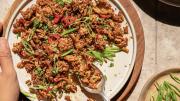University presidents, in general, find the machinations of medical schools arcane, strangely complex, and at times suspiciously devious. Neil Rudenstine, to my great fortune, displayed a very different attitude. In addition to making himself accessible to me as dean of the Faculty of Medicine, Neil has been willing to engage actively with the leaders of Harvard's affiliated hospitals in constructive discussions regarding areas of collaboration, and specifically to lend his moral and personal support to local issues as well as those in Washington.
A hallmark of Neil's leadership has been his willingness, indeed his desire, to participate in meetings involving medical school leaders, hospital CEOs, and board of trustee chairs to address the myriad challenges facing our academic health centers and to identify avenues for taking full advantage of the assets our school brings to the biomedical community and the University at large. It has been in collaborative sessions such as these that we have received encouragement and financial support for the development of a number of new and exciting initiatives, including the digital library at the Countway Library of Medicine and the Academy of Medical Educators, a center designed to facilitate innovation in medical education, foster the teaching abilities of the faculty, and advocate on behalf of teaching in the promotions system.
A particularly significant example of Neil's extraordinary commitment to the medical school was demonstrated two years ago. Many of our clinical faculty members found it difficult to devote the time required for teaching and also earn their living in medical practice. I approached Neil with a proposal to provide additional endowment funding to the departments in which the clinical chairs were housed. These funds were to be used for the specific purpose of sustaining the clinical teaching of our students. Neil responded with enthusiasm and alacrity, gaining Corporation support for the proposal in just a few weeks. This has been a remarkable mechanism for engaging the interest and the commitment of our clinical department heads with the mission of teaching in the medical school.
The Harvard medical community is extraordinarily complex, comprising 17 affiliated (and independent) institutions. But the medical school is more than its affiliated institutions. Clearly, our primary objective is the education of physicians, of biomedical scientists, and of a cadre of individuals who choose to receive training in both the clinical and basic research areas. A number of joint interfaculty collaborations have been developed, although these have never been easy or natural at this university. Neil has embraced the necessity of interdisciplinary and interfaculty work to focus academic strengths on current challenges and opportunities in our society. A remarkable example was the formation in 1997 of the Institute of Chemistry and Cell Biology, a joint effort of the Faculty of Arts and Sciences and the Faculty of Medicine in collaboration with industrial partners, that has created a new field, chemical genetics, which uses small molecules to explore the cellular and physiological function of proteins. Other important collaborations among the Medical School, FAS, the School of Public Health, and the Kennedy School of Government have also been initiated during his leadership. And in the world beyond Harvard, Neil has marshaled our combined intellectual resources to make the case effectively for federal funding of biomedical and scientific research.
I am extremely grateful for the opportunity to have served under Neil's leadership during my last four years here. His warmth, accessibility, wisdom, and willingness to support innovative initiatives have been greatly appreciated and will be much missed.





